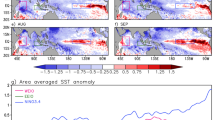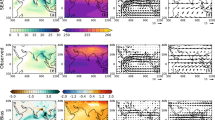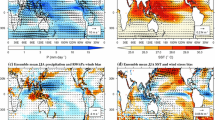Abstract
Documentation of the skill of a prediction system and its comparison with those of leading modelling centres are crucial in model development. This facilitates understanding the limitations of the existing prediction system and aids in its improvement. The current study compares the extended range prediction skill of the Indian Institute of Tropical Meteorology (IITM) generated real-time forecast with that of the UK Met Office (UKMO) forecast during the boreal summer monsoon season. It is found that both models suffer from biases in the climatological mean state of the monsoon. IITM forecast possesses a skill comparable to UKMO coupled seasonal forecast as compared to the observation in the first two weeks leads over most of the meteorological subdivisions during the monsoon months of June to September. However, at longer leads, the UKMO model outperforms the IITM model, which could be credited to its enhanced skill in predicting the monsoon intraseasonal oscillations and the better representation of monsoon variability at the intraseasonal time scale.












Similar content being viewed by others
Funds availability
This work is done under the WCSSP-India Project, and with the exception of GMM, the authors have not received any funding for this.
Data and code availability
The observational datasets used for this study are available free from the respective websites (i) the daily IMD rainfall dataset from http://www.imdpune.gov.in/Clim_Pred_LRF_New/Grided_Data_Download.html (Pai et al. 2021), and (ii) atmospheric fields from the National Center for Environmental Prediction/National Center for Atmospheric Research (NCEP/NCAR) reanalysis datasets https://psl.noaa.gov/data/gridded/data.ncep.reanalysis.html (Kalnay et al. 1996). The GloSea5 and IITM model outputs used in this study are archived at the UK Met Office and IITM, Pune. These as well as the codes used are available to research collaborators upon reasonable request for scientific purposes.
References
Abhilash S, Sahai AK, Borah N et al (2015) Improved spread-error relationship and probabilistic prediction from the CFS-based grand ensemble prediction system. J Appl Meteorol Climatol 54:1569–1578. https://doi.org/10.1175/JAMC-D-14-0200.1
Abhilash S, Mandal R, Dey A et al (2018) Role of enhanced synoptic activity and its interaction with intra-seasonal oscillations on the lower extended range prediction skill during 2015 monsoon season. Clim Dyn. https://doi.org/10.1007/s00382-018-4089-3
Best MJ, Pryor M, Clark DB et al (2011) The Joint UK Land Environment Simulator (JULES), model description – Part 1: Energy and water fluxes. Geosci Model Dev 4:677–699. https://doi.org/10.5194/gmd-4-677-2011
Blockley EW, Martin MJ, McLaren AJ et al (2014) Recent development of the Met Office operational ocean forecasting system: an overview and assessment of the new Global FOAM forecasts. Geosci Model Dev 7:2613–2638. https://doi.org/10.5194/gmd-7-2613-2014
Bowler NE, Arribas A, Beare SE et al (2009) The local ETKF and SKEB: Upgrades to the MOGREPS short-range ensemble prediction system. Q J R Meteorol Soc 135:767–776. https://doi.org/10.1002/qj.394
Dee DP, Uppala SM, Simmons AJ et al (2011) The ERA-Interim reanalysis: configuration and performance of the data assimilation system. Q J R Meteorol Soc 137:553–597. https://doi.org/10.1002/qj.828
Ferranti L, Slingo JM, Palmer TN, Hoskins BJ (1997) Relations between interannual and intraseasonal monsoon variability as diagnosed from AMIP integrations. Q J R Meteorol Soc 123:1323–1357. https://doi.org/10.1002/qj.49712354110
Goswami BN, Mohan RSA (2001) Intraseasonal Oscillations and Interannual Variability of the Indian Summer Monsoon. J Clim 14:1180–1198. https://doi.org/10.1175/1520-0442(2001)014<1180:IOAIVO>2.0.CO;2
Goswami BN, Xavier PK (2005) Dynamics of “internal” interannual variability of the Indian summer monsoon in a GCM. J Geophys Res 110:D24104. https://doi.org/10.1029/2005JD006042
Hunke EC, Lipscomb WH (2010) CICE : the Los Alamos Sea Ice Model Documentation and Software User’s Manual Version 4.1. Tech Rep LA-CC-06-012 1–76
Joseph S, Sahai AK, Shabu H et al (2022) Recent changes in the spatio-temporal characteristics of monsoon intraseasonal oscillations. Theor Appl Climatol 147:251–264. https://doi.org/10.1007/s00704-021-03830-7
Joseph S, Sahai AK, Goswami BN (2010) Boreal summer intraseasonal oscillations and seasonal Indian monsoon prediction in DEMETER coupled models. Clim Dyn. https://doi.org/10.1007/s00382-009-0635-3
Joseph S, Sahai AK, Goswami BN et al (2012) Possible role of warm SST bias in the simulation of boreal summer monsoon in SINTEX-F2 coupled model. Clim Dyn. https://doi.org/10.1007/s00382-011-1264-1
Joseph S, Sahai AK, Phani R et al (2019) Skill evaluation of extended-range forecasts of rainfall and temperature over the meteorological subdivisions of India. Weather Forecast. https://doi.org/10.1175/WAF-D-18-0055.1
Kalnay E, Kanamitsu M, Kistler R et al (1996) The NCEP/NCAR 40-Year Reanalysis Project. Bull Am Meteorol Soc 77:437–471.
Kaur M, Sahai AK, Phani R et al (2022) Multi-physics schema for sub-seasonal prediction of Indian summer monsoon. Clim Dyn 58:669–690. https://doi.org/10.1007/s00382-021-05926-2
Keane RJ, Parker DJ, Fletcher JK (2021) Biases in Indian Summer Monsoon Precipitation Forecasts in the Unified Model and Their Relationship With BSISO Index. Geophys Res Lett. https://doi.org/10.1029/2020GL090529
Kim H-M, Kang I-S, Wang B, Lee J-Y (2008) Interannual variations of the boreal summer intraseasonal variability predicted by ten atmosphere–ocean coupled models. Clim Dyn 30:485–496. https://doi.org/10.1007/s00382-007-0292-3
Krishnamurthy V (2019) Predictability of Weather and Climate. Earth Sp Sci 6:1043–1056. https://doi.org/10.1029/2019EA000586
Krishnamurthy V, Meixner J, Stefanova L et al (2021) Sources of subseasonal predictability over CONUS during Boreal Summer. J Clim 34:3273–3294. https://doi.org/10.1175/JCLI-D-20-0586.1
Lorenz EN (1984) Irregularity: a fundamental property of the atmosphere. Tellus A 36A:98–110. https://doi.org/10.1111/j.1600-0870.1984.tb00230.x
Madden RA, Julian PR (1971) Detection of a 40–50 Day Oscillation in the Zonal Wind in the Tropical Pacific. J Atmos Sci 28:702–708.
Madec G (2008) NEMO ocean engine
Martin GM, Dunstone NJ, Scaife AA, Bett PE (2020) Predicting June Mean Rainfall in the Middle/Lower Yangtze River Basin. Adv Atmos Sci 37:29–41. https://doi.org/10.1007/s00376-019-9051-8
Martin GM, Levine RC, Rodriguez JM, Vellinga M (2021) Understanding the development of systematic errors in the Asian summer monsoon. Geosci Model Dev 14:1007–1035. https://doi.org/10.5194/gmd-14-1007-2021
Mitra AK, Bohra AK, Rajeevan MN, Krishnamurti TN (2009) Daily indian precipitation analysis formed from a merge of rain-gauge data with the TRMM TMPA satellite-derived rainfall estimates. J Meteorol Soc Japan Ser II 87A:265–279
Pai D, Rajeevan M, Sreejith O et al (2021) Development of a new high spatial resolution (0.25° × 0.25°) long period (1901–2010) daily gridded rainfall data set over India and its comparison with existing data sets over the region. MAUSAM 65:1–18. https://doi.org/10.54302/mausam.v65i1.851
Rajeevan M, Gadgil S, Bhate J (2010) Active and break spells of the Indian summer monsoon. J Earth Syst Sci 119:229–247. https://doi.org/10.1007/s12040-010-0019-4
Saha S, Moorthi S, Pan H-L et al (2010) The NCEP Climate Forecast System Reanalysis. Bull Am Meteorol Soc 91:1015–1058. https://doi.org/10.1175/2010BAMS3001.1
Sahai AK, Chattopadhyay R, Joseph S et al (2014) A new method to compute the principal components from self-organizing maps: An application to monsoon intraseasonal oscillations. Int J Climatol. https://doi.org/10.1002/joc.3885
Sahai AK, Abhilash S, Chattopadhyay R et al (2015) High-resolution operational monsoon forecasts: an objective assessment. Clim Dyn. https://doi.org/10.1007/s00382-014-2210-9
Sahai AK, Kaur M, Joseph S et al (2021) Multi-Model Multi-Physics Ensemble: A Futuristic Way to Extended Range Prediction System. Front Clim. https://doi.org/10.3389/fclim.2021.655919
Shukla J, Gutzler DS (1983) Interannual Variability and Predictability of 500 mb Geopotential Heights over the Northern Hemisphere. Mon Weather Rev 111:1273–1279. https://doi.org/10.1175/1520-0493(1983)111%3c1273:IVAPOM%3e2.0.CO;2
Sikka DR, Gadgil S (1980) On the Maximum Cloud Zone and the ITCZ over Indian, Longitudes during the Southwest Monsoon. Mon Weather Rev 108:1840–1853. https://doi.org/10.1175/1520-0493(1980)108%3c1840:OTMCZA%3e2.0.CO;2
Srivastava A, Rao SA, Pradhan M et al (2021) Gain of one-month lead time in seasonal prediction of Indian summer monsoon prediction: comparison of initialization strategies. Theor Appl Climatol 143:1083–1096. https://doi.org/10.1007/s00704-020-03470-3
Suhas E, Neena JM, Goswami BN (2013) An Indian monsoon intraseasonal oscillations (MISO) index for real time monitoring and forecast verification. Clim Dyn 40:2605–2616. https://doi.org/10.1007/s00382-012-1462-5
Taylor KE (2001) Summarizing multiple aspects of model performance in a single diagram. J Geophys Res Atmos 106:7183–7192. https://doi.org/10.1029/2000JD900719
Walters D, Boutle I, Brooks M et al (2017) The Met Office Unified Model Global Atmosphere 6.0/6.1 and JULES Global Land 6.0/6.1 configurations. Geosci Model Dev 10:1487–1520. https://doi.org/10.5194/gmd-10-1487-2017
Wehrli K, Guillod BP, Hauser M et al (2018) Assessing the Dynamic Versus Thermodynamic Origin of Climate Model Biases. Geophys Res Lett 45:8471–8479. https://doi.org/10.1029/2018GL079220
Wilks DS (2011) Statistical Methods in the Atmospheric Sciences, third. Elsevier
Williams KD, Harris CM, Bodas-Salcedo A et al (2015) The Met Office Global Coupled model 2.0 (GC2) configuration. Geosci Model Dev 8:1509–1524. https://doi.org/10.5194/gmd-8-1509-2015
Willmott CJ (1981) On the validation of models. Phys Geogr 2:184–194. https://doi.org/10.1080/02723646.1981.10642213
Zheng Y, Bourassa MA, Ali MM, Krishnamurti TN (2016) Distinctive features of rainfall over the Indian homogeneous rainfall regions between strong and weak Indian summer monsoons. J Geophys Res Atmos 121:5631–5647. https://doi.org/10.1002/2016JD025135
Acknowledgements
We express gratitude to the Director, IITM, for all the support in carrying out this work. The Ministry of Earth Sciences (MoES), under the Government of India supports IITM. This work, and the contribution by GM Martin, was conducted through the Weather and Climate Science for Service Partnership (WCSSP) India, a collaborative initiative between the Met Office, supported by the UK Government’s Newton Fund, and MoES. We thank NCEP/NCAR, NOAA, and IMD for freely providing the observational data. The free plotting software, GrADS (available at http://iges.org/grads/) and GRACE, and free writing assistant Grammarly are duly acknowledged. Special thanks to Dr Manpreet Kaur for proofreading the initial draft. We sincerely thank the Editor and two anonymous reviweres for their insightful and constructive comments, which helped considerably in improving the scientific content of our work.
Author information
Authors and Affiliations
Contributions
The study was conceptualised by Susmitha Joseph, Rajib Chattopadhyay and AK Sahai. The GloSea5 model data was provided by Gill M Martin as part of the WCSSP-India Project. Material preparation and analysis were performed by Susmitha Joseph and Rajib Chattopadhyay. Avijit Dey, Raju Mandal and R Phani contributed to the IITM model runs. Susmitha Joseph wrote the initial draft of the manuscript, and all authors commented on previous versions of the manuscript. All authors have read and approved the final manuscript.
Corresponding author
Ethics declarations
Competing interests
The authors declare no competing interests.
Ethics approval
Not applicable.
Consent to participate
Not applicable.
Consent for publication
Not applicable.
Additional information
Publisher's Note
Springer Nature remains neutral with regard to jurisdictional claims in published maps and institutional affiliations.
Supplementary Information
Below is the link to the electronic supplementary material.
Rights and permissions
Springer Nature or its licensor (e.g. a society or other partner) holds exclusive rights to this article under a publishing agreement with the author(s) or other rightsholder(s); author self-archiving of the accepted manuscript version of this article is solely governed by the terms of such publishing agreement and applicable law.
About this article
Cite this article
Joseph, S., Chattopadhyay, R., Sahai, A.K. et al. Evaluation and comparison of the subseasonal prediction skill of Indian summer monsoon in IITM CFSv2 and UKMO GloSea5. Clim Dyn 61, 1683–1696 (2023). https://doi.org/10.1007/s00382-022-06650-1
Received:
Accepted:
Published:
Issue Date:
DOI: https://doi.org/10.1007/s00382-022-06650-1




